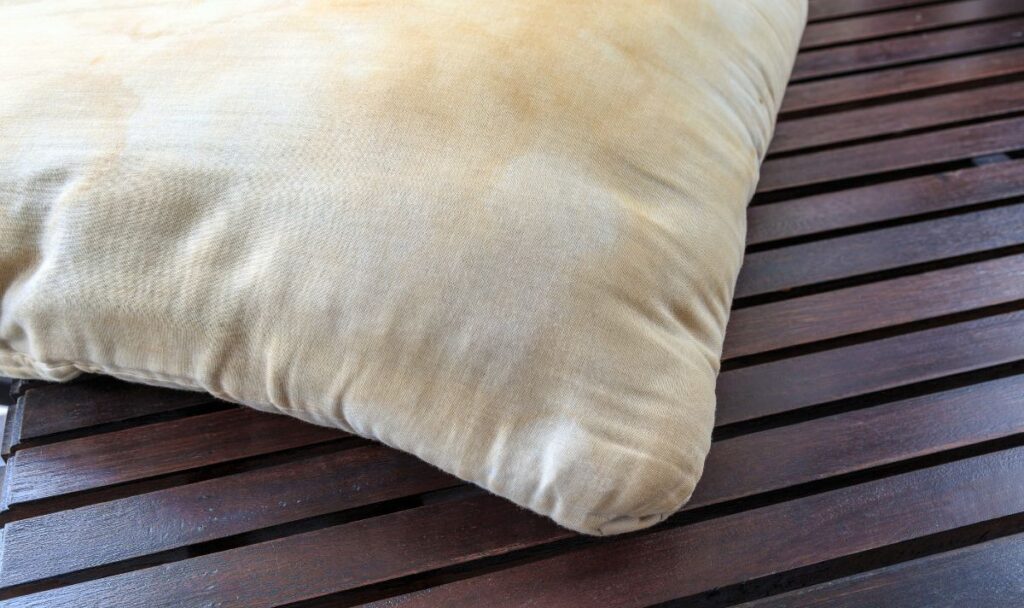Washing pillows helps to get rid of sweat, oils, bacteria and dust mites to name a few. It could also give them a fresh look and smell, prolonging the life of them. It may be tricky to know how to clean pillows due to their material and size, so experts have shared various methods to use, including spot cleaning and deep cleaning.
With over 40 years in the sleep industry, the owner of Bed Guru, Carl Walsh, shared the best ways to clean pillows, including how to spot clean, which should be done if small stains appear on the pillow.
The expert said: “To spot clean, take off the pillowcase and mix a mid detergent with water until it bubbles. Then, gently rub the solution into the stain with a sponge until it comes out and allow to air dry.
“If your pillow is smelling funny and you want to give it a refresh, here is what you need to do. Take off the pillow case and lie it on a flat surface.
“Sprinkle baking soda over your pillow before leaving it in direct sunlight for two to three hours. Then, vacuum off the baking soda thoroughly and it’ll be as good as new.”
READ MORE: ‘Common’ pruning mistakes which could ‘permanently damage’ a plant
“Once the water runs clear, gently squeeze your pillow to get rid of as much excess water as possible. It is important that you don’t squeeze it too hard or twist your pillow. Once you have done this, leave it to air dry.”
If a pillow has yellow stains on it, there could be a number of reasons causing them to occur. It is best to clean these as soon as possible otherwise they may not come out, even in the wash.
Experts at Smol, an eco-effective cleaning brand, said: “Your first task when it comes to removing yellow stains from your pillows is to identify what’s causing the staining, because the cause will impact the suitable treatment.
“Oil from your hair and skin, called sebum, can produce yellow staining. A simple fix for these stains is shampoo – apply to the stain and leave to soak in warm water before giving it a good scrub and adding to the wash as normal.
READ MORE: Christmas-flowering houseplants to ‘dispel winter dullness’
This can break down the proteins in common stains. The pros said: “Most stain removers simply bleach your clothes clean, using high concentrations of harsh chemicals that can damage fabrics and even irritate skin.”
Experts recommend pillows are washed or cleaned every three months to help prevent germs and bacteria building-up. It is also important to change pillowcases regularly to help prevent acne.
According to an expert, mattresses also need to be cleaned as they could be home to a million dust mites, causing allergies or asthma to worsen.
Martin Seeley, the CEO and sleep expert at MattressNextDay, said: “Before you start, it’s essential to check the care instructions on your mattress. If you take action that damages the foam, you may find that your warranty becomes invalid. So read your care instructions.
“The first step in cleaning your memory foam mattress is to use a mild detergent solution on the stain. Use warm water and apply the solution directly onto the stain with a sponge or rag.
“Apply enough pressure so that it penetrates into the surface of the mattress, but not so much that it pushes out any of the stuffing inside of it.
“After five minutes, use another sponge or rag and rinse away any excess liquid from the surface of your memory foam mattress. If there’s still some left behind, continue soaking until all of the liquid has been removed from both sides of your mattress cover.
“Once you’ve removed all of the excess liquid, place your memory foam mattress in direct sunlight to dry. If it’s cold outside, use a fan to blow warm air over the wet spots on your mattress cover so that they dry faster.”

